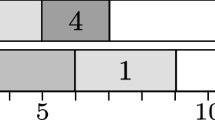Abstract
We present a parallel algorithm for the two processor scheduling problem. This algorithm constructs an optimal schedule for unit execution time task systems with arbitrary precedence constraints using a polynomial number of processors and running in time polylog in the size of the input. Whereas previous parallel solutions for the problem made extensive use of randomization, our algorithm is completely deterministic and based on an interesting iteration technique. It is of independent relevance for two more reasons. It provides another example for the apparent difference in complexity between decision and search problems in the context of fast parallel computation, and it gives an NC-algorithm for the matching problem in certain restricted cases.
This work was supported in part by a grant from AT&T Foundation, ONR contract N00014-85-C-0731, and NSF grant DCR-8351757.
Preview
Unable to display preview. Download preview PDF.
Similar content being viewed by others
References
Coffman, E.G., Jr., and R.L. Graham “Optimal Scheduling for Two Processor Systems," Acta Informatica 1 (1972), pp. 200–213.
Dolev, D., E. Upfal, and M. Warmuth, “Scheduling Trees in Parallel,” In: Bertolazzi, P, Luccio, F. (eds.): VLSI: Algorithms and Architectures. Proceedings of the of the International Workshop on Parallel Computating and VLSI, Amalfi, Italy (May 1984): North-Holland 1985, p. 1–30.
Fujii, M., T. Kasami, and K. Ninamiya, “Optimal Sequencing of Two Equivalent Processors," SIAM J. of Computing 17 (1969), pp. 784–789.
Gabow, H.N., “An Almost-linear Algorithm for Two-processor Scheduling,” J.ACM 29,3 (1982), pp. 766–780.
Gabow, H.N. and Tarjan, R.E., “A Linear Time Algorithm for a Special Case of Disjoint Set Union”, Proceedings of the 15th Ann. ACM Symposium on Theory of Computing (Boston, Mass., 1983), pp. 246–251.
Ghouilà-Houri, A., “Charactérisation des graphes non orientés dont on peut orienter les arrêtes de manière à obtenir le graphe d'une relation d'ordre,” C.R. Acad. Sci. Paris 254 (1962).
Helmbold, D. and E. Mayr, “Fast Scheduling Algorithms on Parallel Computers,” STAN-CS-84-1025, Department of Computer Science, Stanford University (November 1984). To appear in Advances in Computing Research.
Helmbold, D. and E. Mayr, “Transitive Orientation and NC Algorithms,” in preparation.
Hu, T.C., “Parallel Sequencing and Assembly Line Problems,” Operations Research 9 (1961), pp. 841–848.
Karp, R.M., E. Upfal, and A. Wigderson, “Constructing a Perfect Matching is in Random NC,” Proceedings of the 17th Ann. ACM Symposium on Theory of Computing (Providence, RI, 1985), pp. 22–32.
Karp, R.M., E. Upfal, and A. Wigderson, “Are Search and Decision Problems Computationally Equivalent?,” Proceedings of the 17th Ann. ACM Symposium on Theory of Computing (Providence, RI, 1985), pp. 464–475.
Kozen, D., U.V. Vazirani, and V.V. Vazirani, “NC Algorithms for Comparability Graphs, Interval Graphs, and Testing for Unique Perfect Matching,” to appear.
Papadimitriou, C.H. and Yannakakis, M., “Scheduling Interval-Ordered Tasks,” SIAM J. Computing 8,3 (1979).
Pnueli, A., A. Lempel, and S. Even, “Transitive Orientation of Graphs and Identification of Permutation Graphs,” Can. J. Math. 23,1 (1971), pp. 160–175.
Ullman, J.D., “NP-complete Scheduling Problems," J. Comput. System Sci. 10 (1975), pp. 384–393.
Vazirani, U.V. and V.V. Vazirani, “The Two-Processor Scheduling Problem is in RNC,” Proceedings of the 17th Ann. ACM Symposium on Theory of Computing (Providence, RI, 1985), pp. 11–21.
Author information
Authors and Affiliations
Editor information
Rights and permissions
Copyright information
© 1986 Springer-Verlag Berlin Heidelberg
About this paper
Cite this paper
Helmbold, D., Mayr, E. (1986). Two processor scheduling is in NC . In: Makedon, F., Mehlhorn, K., Papatheodorou, T., Spirakis, P. (eds) VLSI Algorithms and Architectures. AWOC 1986. Lecture Notes in Computer Science, vol 227. Springer, Berlin, Heidelberg. https://doi.org/10.1007/3-540-16766-8_2
Download citation
DOI: https://doi.org/10.1007/3-540-16766-8_2
Published:
Publisher Name: Springer, Berlin, Heidelberg
Print ISBN: 978-3-540-16766-2
Online ISBN: 978-3-540-38746-6
eBook Packages: Springer Book Archive




